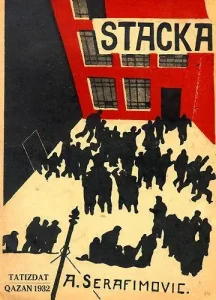Revolutions in Reel-Time: How Eisenstein's 'Strike' (1925) Ignited Cinema with the Fire of Montage!
In the tumultuous aftermath of the 1917 Bolshevik Revolution, Soviet Russia became an unlikely crucible for cinematic innovation, and at its fiery heart stood Sergei Eisenstein. Far more than just a filmmaker, Eisenstein was a radical theorist and a relentless experimenter, convinced that cinema was the most potent weapon for propaganda and a transformative art form capable of shaping collective consciousness. His groundbreaking work redefined the very language of film, particularly through his revolutionary theories of montage – the art of juxtaposition and collision editing, where the clash of images creates new ideas and powerful emotional impact, rather than simply maintaining narrative continuity. His debut feature, Strike (1925), or Stachka, immediately announced him as a cinematic titan. This film wasn't merely a story; it was a furious, visceral declaration of his artistic and political philosophy, a cinematic sledgehammer that smashed conventional storytelling and forever altered the trajectory of world cinema, paving the way for every politically charged, formally audacious film that followed.
Strike plunges us into the brutal, dehumanizing reality of a pre-revolutionary Russian factory, where the oppressive conditions and stark injustices faced by the workers reach a boiling point. The spark is ignited by a minor theft, leading to the wrongful accusation and subsequent suicide of a worker. This act of despair quickly mobilizes the factory's desperate labor force into an organized, furious strike. The film portrays the workers not as individual heroes, but as a unified, suffering, and ultimately defiant collective, battling against the cold, calculated oppression of the factory owners and their ruthless capitalist system. The narrative is a raw, unflinching depiction of class struggle, escalating from tense negotiations and organized resistance to sabotage, brutal suppression by the military and police, and the tragic, violent consequences of their stand, painting a stark picture of revolution's painful birth.
Sergei Eisenstein's directorial genius is on full, electrifying display throughout Strike, pioneering techniques that would become his hallmark. The film is a masterclass in his theory of "collision montage," using rapid-fire cuts and sharp juxtapositions of images – such as the infamous sequence cross-cutting the slaughter of workers with the brutal slaughter of a bull – to create potent emotional and intellectual resonance. This wasn't subtle; it was a deliberate shock to the system, designed to provoke thought and incite revolutionary fervor. The cinematography is equally radical, employing dramatic angles, close-ups, and a stark visual aesthetic that transforms the factory into a character and the workers into powerful symbols of collective will. It's a relentless, visceral experience that, despite its age and silent format, still possesses an astonishing power to engage and disturb, proving that film could be a direct, ideological weapon.
Despite its initial purpose as revolutionary propaganda, Strike transcended its political aims to become a foundational cult film revered by cinephiles, film students, and historians worldwide for its sheer innovation. It effectively established Eisenstein as a master of montage, a technique he would perfect in his subsequent works like Battleship Potemkin. The "cast" is largely comprised of non-professional actors drawn from actual factory workers and local communities, lending an undeniable authenticity to their portrayal of the collective struggle. The film was produced by Goskino, the state film company, reflecting its Soviet purpose. Strike remains an essential viewing for anyone seeking to understand the birth of modern cinematic language, the power of political filmmaking, and the enduring, shocking genius of one of cinema's most revolutionary figures.
Director: Sergei Eisenstein.
Cast: Grigori Aleksandrov as Foreman, Aleksandr Antonov as Member of the Strike Committee, I. Ivanov as Chief of Police, Maksim Shtraukh as Police Spy, Mikhail Gomorov as Worker, and Judith Glizer as Worker. (Many of the roles were played by non-professional actors).
Special Info/Trivia: This was Sergei Eisenstein's first full-length feature film. It is a seminal work in the development of montage theory in cinema, particularly "collision montage." The famous scene of a bull being slaughtered in parallel with the workers being massacred is one of the most iconic examples of montage. The film heavily features non-professional actors. It was produced by Goskino, the Soviet state film company.

